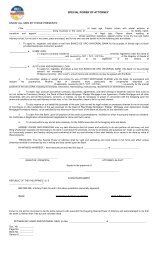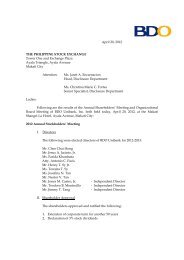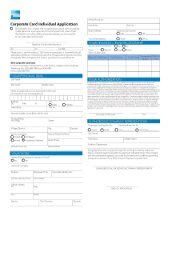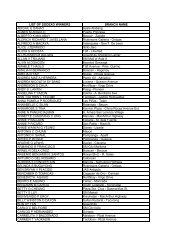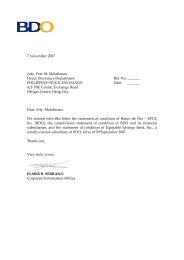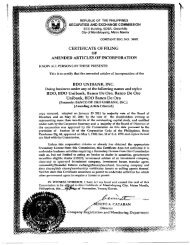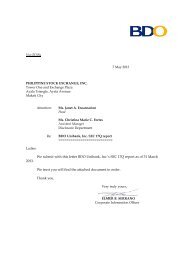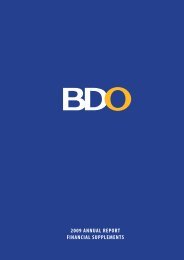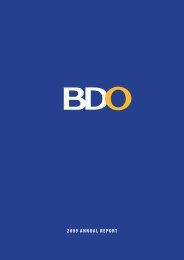<strong>Notes</strong> <strong>to</strong> <strong>Financial</strong> <strong>Statements</strong>DECEMBER 31, 2008, 2007 AND 2006(Amounts in Millions Except Per Share Data)(b)Functional and Presentation CurrencyThese financial statements are presented in Philippines pesos, the Group’s functional and presentation currency, and all values representabsolute amounts, except when otherwise indicated (see also Note 2.22).2.2 Impact of New Standards, Amendments and Interpretations <strong>to</strong> Existing Standards(a)Effective in 2008 that are Relevant <strong>to</strong> the GroupIn 2008, the Group adopted for the first time the following new interpretations and amended standards which are manda<strong>to</strong>ry in 2008:Philippine Interpretation : The Limit on a Defined BenefitIFRIC 14, PAS 19Assets, Minimum FundingRequirements and theirInteractionPhilippine Accounting : PAS 39, <strong>Financial</strong> Instruments :Standard (PAS) 39 andRecognition and Measurements andPFRS 7 (Amendment) PFRS 7, <strong>Financial</strong> Instruments :DisclosuresPhilippine Interpretation : Group and Treasury Share TransactionsIFRIC 11Discussed below are the effects in the financial statements of the new accounting interpretations and amended standards.(i)On Oc<strong>to</strong>ber 29, 2008, the FRSC approved the immediate adoption of amendments <strong>to</strong> IAS 39, <strong>Financial</strong> Instruments: Recognition andMeasurement, and IFRS 7, <strong>Financial</strong> Instruments: Disclosures: Reclassification of <strong>Financial</strong> Assets, issued by the IASB as amendments <strong>to</strong>PAS 39 and PFRS 7. Adoption of the amendments enables Philippine entities applying PFRSs <strong>to</strong> avail of the allowed internationalaccounting treatments. The amendments <strong>to</strong> PAS 39 permit an entity <strong>to</strong>, among others:• reclassify non-derivative financial assets, other than those designated at FVTPL upon initial recognition, out of the FVTPLcategory:a. only in rare circumstances and if there is a change in intention (i.e., the financial asset is no longer held for the purpose ofselling or repurchasing it in the near future); or,b. if the financial asset would have met the definition of loans and receivables and if the financial asset had not been required<strong>to</strong> be classified as held-for-trading (HFT) at initial recognition and the entity has the intention and ability <strong>to</strong> hold the financialasset for the foreseeable future or until maturity.• transfer from available-for-sale (AFS) category <strong>to</strong> the loans and receivables category a non-derivative financial asset that wouldhave met the definition of loans and receivables if the entity has the intention and ability <strong>to</strong> hold that financial asset for theforeseeable future or until maturity.Related <strong>to</strong> this, the Monetary Board of the BSP approved the prudential reporting guidelines for banks governing the reclassificationof investments in debt and equity securities between categories in accordance with the provisions of the Oc<strong>to</strong>ber 2008 amendments<strong>to</strong> the PAS 39 and PFRS 7, and provided additional guidelines (under BSP Circular No. 628) which include; among others, thereclassification of CLNs and other similar instruments that are linked <strong>to</strong> ROP bonds:• out of the HFT in<strong>to</strong> AFS/held-<strong>to</strong>-maturity (HTM)/ UDSCL; or,• from AFS <strong>to</strong> UDSCL or HTM, without bifurcating the embedded derivatives from the host instruments;Provided that these shall only apply for CLNs that are outstanding as of the effective date of reclassification, which shall not be onor later than November 15, 2008.On February 2, 2009, the SEC approved the adoption of BSP Circular 628 as being compliant with generally accepted accountingprinciples for banks.Pursuant <strong>to</strong> these amendments and guidelines, the Group reclassified certain financial assets out of FVTPL and AFS categories <strong>to</strong>HTM and loans and receivables categories (see Note 9).(ii)In 2008, the Group adopted for the first time the Philippine Interpretation, International <strong>Financial</strong> Reporting Interpretation Committee(IFRIC) 14, PAS 19 – The Limit on a Defined Benefit Asset, Minimum Funding Requirements and their Interaction (effective fromJanuary 1, 2008). This Philippine Interpretation provides general guidance on how <strong>to</strong> assess the limit in PAS 19, Employee Benefits,on the amount of the surplus that can be recognized as an asset. It also explains how the pension asset or liability may be affectedby statu<strong>to</strong>ry or contractual minimum funding requirement. The Group’s adoption of this interpretation does not have any impact onthe Group’s financial statements, as its retirement benefit plan is still partially unfunded.(iii) In 2008, the Group adopted for the first time the Philippine Interpretation International <strong>Financial</strong> Reporting Interpretation Committee(IFRIC) 11, Group and Treasury Shares Transactions (effective from March 1, 2007). This standard addresses the issue relating <strong>to</strong> anentity’s obligation <strong>to</strong> provide its employees, as well as other third parties, with its own equity instrument (i.e., treasury shares) or theequity instrument of its shareholder (SMIC). The Parent Bank is obligated <strong>to</strong> provide the Group’s employees with its equity shares10Thinking Ahead To Get You Ahead • Annual Report 2008
<strong>Notes</strong> <strong>to</strong> <strong>Financial</strong> <strong>Statements</strong>DECEMBER 31, 2008, 2007 AND 2006(Amounts in Millions Except Per Share Data)and such transaction is accounted for as equity settled in the Group financial statements. Under this Philippine Interpretation, theGroup is required <strong>to</strong> measure the services received from the employees in accordance with the requirements applicable <strong>to</strong> equitysettledshare-based payment transactions, with a corresponding increase recognized in the Group’s equity as a contribution fromthe shareholders.The first-time application of these amended standards, and interpretations has not resulted in any prior period adjustments of cashflows, net income or statement of condition line items.(b)Effective in 2008 but not Relevant <strong>to</strong> the GroupPhilippine Interpretation : Service Concession ArrangementsIFRIC 12(c)Effective Subsequent <strong>to</strong> 2008 that is Relevant <strong>to</strong> the GroupThere are new and amended standards and Philippine Interpretation that are effective for periods subsequent <strong>to</strong> 2008. The followingnew standards are relevant <strong>to</strong> the Group which the Group will apply in accordance with their transitional provisions.PAS 1 (Revised 2007) : Presentation of <strong>Financial</strong> <strong>Statements</strong>PAS 23 (Revised 2007) : Borrowing CostsPAS 32 and PAS 1 : <strong>Financial</strong> Instruments: Presentation and(Amendment)Presentation of <strong>Financial</strong> <strong>Statements</strong>- Puttable <strong>Financial</strong> Instruments andObligations Arising on LiquidationVarious Standards : 2008 Annual Improvements <strong>to</strong> PFRSBelow is a discussion of the possible impact of these accounting standards:(i)(ii)PAS 1 (Revised 2007), Presentation of <strong>Financial</strong> <strong>Statements</strong> (effective from January 1, 2009). The amendment requires an entity<strong>to</strong> present all items of income and expense recognized in the period in a single statement of comprehensive income or in twostatements: a separate income statement and a statement of comprehensive income. The income statement shall disclose incomeand expense recognized in profit and loss in the same way as the current version of PAS 1. The statement of comprehensiveincome shall disclose profit or loss for the period, plus each component of income and expense recognized outside of profit andloss classified by nature (e.g., gains or losses on available-for-sale assets or translation differences related <strong>to</strong> foreign operations).Changes in equity arising from transactions with owners are excluded from the statement of comprehensive income (e.g., dividendsand capital increase). An entity would also be required <strong>to</strong> include in its set of financial statements a statement showing its financialposition (statement of condition) at the beginning of the previous period when the entity retrospectively applies an accountingpolicy or makes a retrospective restatement. The Group will apply PAS 1 (Revised 2007) in its 2009 financial statements.PAS 23 (Revised 2007), Borrowing Costs (effective from January 1, 2009). Under the revised PAS 23, all borrowing costs that aredirectly attributable <strong>to</strong> the acquisition, construction or production of a qualifying asset shall be capitalized as part of the cost ofthat asset. The option of immediately expensing borrowing costs that qualify for asset recognition has been removed. The Grouphas initially determined that adoption of this new standard will not have significant effects on the financial statements for 2009, aswell as for prior and future periods, as the Group’s current accounting policy is <strong>to</strong> capitalize all interest directly related <strong>to</strong> qualifyingassets.(iii) PAS 32 (Amendment), <strong>Financial</strong> Instruments: Presentation and PAS 1 (Amendment), Presentation of <strong>Financial</strong> <strong>Statements</strong> – Puttable<strong>Financial</strong> Instruments and Obligations Arising on Liquidation (effective from January 1, 2009). The amendments require certainfinancial instruments that represent a residual interest in the net assets of an entity, which would otherwise be classified as financialliabilities, <strong>to</strong> be classified as equity, if both the financial instrument and the capital structure of the issuing entity meet certainconditions. The Group does not expect any impact on its financial statements when it applies the amendments in 2009.(iv) 2008 Annual Improvements <strong>to</strong> PFRS. The FRSC has adopted the Improvements <strong>to</strong> International <strong>Financial</strong> Reporting Standards2008. These amendments become effective in the Philippines in annual periods beginning on or after January 1, 2009. The Groupexpects the amendments <strong>to</strong> the following standards <strong>to</strong> be relevant <strong>to</strong> the Group’s accounting policies:• PAS 23 (Amendment), Borrowing Costs. The amendment clarifies the definition of borrowing costs <strong>to</strong> include interest expensedetermined using the effective interest method under PAS 39. This amendment will be applied by the Group in 2009; however,management expects its effect <strong>to</strong> be insignificant.• PAS 1 (Amendment), Presentation of <strong>Financial</strong> <strong>Statements</strong>. The amendment clarifies that financial instruments classified asheld for trading in accordance with PAS 39 are not necessarily required <strong>to</strong> be presented as current assets or current liabilities.Instead, normal classification principles under PAS 1 should be applied. The Group determines that this amendment willhave no impact in the Group’s 2009 financial statements.• PAS 19 (Amendment), Employee Benefits. The amendment includes the following:- Clarification that a curtailment is considered <strong>to</strong> have occurred <strong>to</strong> the extent that benefit promises are affected by futuresalary increases and a reduction in the present value of the defined benefit obligation results in negative past servicecost.Thinking Ahead To Get You Ahead • Annual Report 2008 11



